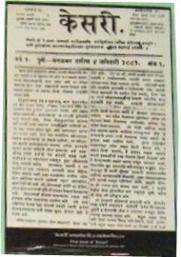Kesari (newspaper)
 | |
| Type | Daily newspaper |
|---|---|
| Founded | 1881 |
| Language | Marathi |
| Website | dailykesari.com |
Kesari (Marathi: केसरी Sanskrit for Lion) is a Marathi newspaper which was founded in 1881 by Lokmanya Bal Gangadhar Tilak, a prominent leader of the Indian Independence movement. The newspaper was used as a spokes piece for the Indian national freedom movement, and continues to be published by the Kesari Mahratta Trust and Tilak's descendants.[1][2][3]
Bal Gangadhar Tilak used to run his two newspapers, Kesari, in Marathi and Mahratta[4] in English from Kesari Wada, Narayan Peth, Pune. The newspapers were originally started as a co-operative by Chiplunkar, Agarkar and Tilak. The Wada (Marathi for courtyard / building) still has the offices of Kesari, and mementos of Tilak, including his writing desk original letters and documents, and the first India national flag unfurled by Madame Cama. During Ganapati festival, the Wada is visited by a large number of people.[5]
Initial years, editors and writers
The editors of Kesari included a number of freedom fighters and social activists / reformers, including Agarkar (its first editor), Chiplunkar and Tilak.[6] Agarkar left Kesari in 1887 to start his own news paper, Sudharak (the reformer) after which Tilak continued to run the paper on his own.
The Kesari and the Kolhapur Affair
This was a particular controversy regarding the ‘madness’ of Shivaji IV, the minor Raja (king) of Kolhapur (Chhatrapati), a princely state in the southern part of Bombay Presidency, which took place in early 1880s. The British officials and doctors were of the opinion that Shivaji IV was suffering from an incurable ‘madness’. This official version received support from English newspapers such as the Times of India and the Bombay Gazette.
However, some Indian-owned newspapers such as Induprakash, Mahratta and Kesari disputed this. In the Kesari there was a public questioning of the diagnosis, treatment and mental state of the Chhatrapati. The Kesari, then under the editorship of Agarkar, and the Mahratta under Tilak, argued that Shivaji IV was not ‘mad’ and the little instability in his mental state was caused by the maltreatment given to him by the servants and officials appointed to take care of him.
They especially accused Mahadeo Barve, the British appointed Karbhari (Chief Administrator) of Kolhapur for complicity in a conspiracy to make Shivaji IV mad. They published in the Kesari and Mahratta letters allegedly written by Mahadeo Barve to his subordinate officials, which indicated his involvement along with some British officials and native servants in a plot to poison Shivaji IV.
To clear himself of the charges, Mahadeo Barve filed a defamation case against Tilak and Agarkar. The trial which followed brought into the public sphere the private life of Shivaji IV and the ill treatment meted out to him by British officials .
The Kesari published the verbatim account of the High Court trial drama, which in its editors' opinion exposed to public scrutiny the barbarous attitude of the British officers towards Shivaji IV. On 16 July 1882m the jury found Tilak and Agarkar guilty on the charge of slander against Madhav Barve and sentenced them to four months’ imprisonment at the Dongri jail in Bombay.
Even during the trial, Kesari published articles which questioned the physical control of British officers over the body of Shivaji IV and expressed fears regarding danger to Shivaji IV’s life from officers appointed to protect him. In spite of such accusations the British Government did not remove Shivaji IV from the custody of these officers. Eventually, Shivaji IV died on December 25, 1883 in a scuffle with a British soldier appointed to take care of him. The whole episode became famous as the Kolhapur Prakaran (affair).
Kesari Prosecution of 1897
Bal Gangadhar Tilak mentions that the letter he received from Swami Vivekananda must have been destroyed along with many others after the close of the Kesari Prosecution of 1897.[7]
Present Day Kesari
The building that housed the offices of Kesari in Pune still exists in Tilakwada and contains the Tilak museum and Kesari-Maratha library.[8] An online Marathi periodical called The Daily Kesari continues to be published, edited by Lokmanya Balgangadhar Tilak's great grandson, Deepak Tilak.[9]
See also
References
- ↑ "About the Vice Chancellor - Deepak J.Tilak". http://www.tmv.edu.in. Tilak Maharashtra Vidyapeeth. Retrieved 17 June 2014. External link in
|website=(help) - ↑ "Retracing the legend of Gangadhar Tilak at Kesariwada". http://indiaheritagesites.wordpress.com. Blog - Indian Heritage Sites. Retrieved 17 June 2014. External link in
|website=(help) - ↑ Inamdar, Siddhesh (January 4, 2010). "Tendency to dumb down journalism disturbing: N. Ram". Pune: The Hindu. Retrieved January 7, 2013.
- ↑ Mone (Tilak), Mrs. Geetali Hrishikesh. "THE ROLE OF FREE CIRCULATION IN OPTIMUM NEWSPAPER MANAGEMENT - Phd. Thesis submission". shodhganga.inflibnet.ac.in. Preface - Shodhganga. Retrieved 17 June 2014.
- ↑ "Kesari Wada". http://www.maharashtratourism.net. Maharashtra Tourism. Retrieved 17 June 2014. External link in
|website=(help) - ↑ "Bal Gangadhar Tilak and Kesari". http://wiki.phalkefactory.net. The Tilak Phalke Factory. Retrieved 18 June 2014. External link in
|website=(help) - ↑ http://www.ramakrishnavivekananda.info/reminiscences/020_bgt.htm
- ↑ "Kesari Wada". http://www.punesite.com. Pune Site. Retrieved 17 June 2014. External link in
|website=(help) - ↑ "Know your city - Pune". Indian Express. Retrieved 17 June 2014.